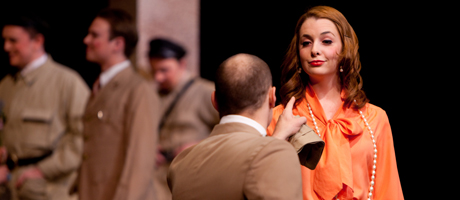By Menachem Wecker
As Shakespeare in the Park aficionados can attest, many contemporary adaptations set the Bard’s plays in modern times -- a visual move which, when it works, illustrates the timelessness of the script. The Department of Theatre and Dance’s production of Much Ado About Nothing, Feb. 18 – 21, depicts Shakespeare’s comedy in interbellum Italy. The adaptation is particularly successful due to its simple, classical and monumental set design.
“I think it was an interesting choice for the production to be set in the 1920s, because it is a departure from traditional Shakespearian productions,” says junior Sharon Strich, a theater major and assistant set designer for Much Ado. “As someone who really enjoys Shakespeare, I like watching productions set in different time periods, because it is a different way to experience the classic text.”
According to Alan Wade, professor of theatre and director of both the Dean’s Scholars in Shakespeare and the performance of Much Ado, the students and faculty on the department’s production committee selected the play. Dr. Wade calls Much Ado “one of the best structured of Shakespeare’s plays with two sub-plot characters [Beatrice and Benedick] who have, over the four centuries since its first performance, taken the play over.”
The multilayered plot of Much Ado includes the courtship of Hero by Claudio, a young soldier, and the villain Don John’s attempts to derail it. Simultaneously woven into this conflict, as only Shakespeare can do, Don John’s brother Don Pedro, Hero and a host of other characters play a trick on the constantly bickering Beatrice and Benedick, telling each one of the other’s secret love.
The play is a comedy, so without any spoiler alerts, it ends with marriage rather than death, but the beauty of the script lies in how the story unfolds and in the complexity of the characters.
“The most difficult thing about playing Claudio was balancing his soldierly experience and bearing with his emotional immaturity,” says junior Calder Stembel, a dramatic literature major. “He is rather comfortable and jovial around his fellow soldiers but inexperienced when it comes to social interactions and courtship rituals. Whenever he doesn’t know how to act, he falls back on the familiar military formality.”
Mr. Stembel notes that his character assumes the stage after the audience has been told about “right noble Claudio,” who “hath borne himself beyond the promise of his age.”
“Yet the audience hardly sees this in Claudio during the play,” says Mr. Stembel. “Placed in uncertain social territory, he appears young, vulnerable, emotionally compromised and gullible – the perfect pawn for Don John.”
Reading the script to prepare for the show, Mr. Stembel realized Claudio was almost never in control of his destiny. “Other characters woo for him, deceive him easily and arrange his reconciliatory marriage,” says Mr. Stembel.
Both Mr. Stembel and Dr. Wade say the play’s soundtrack -- GW jazz musicians -- made a huge difference. “Let me remark on how important the contribution of the jazz ensemble is to this production,” says Dr. Wade. “Expert musicians who can, you’ll pardon the pun, take a note and run with it.”
“We found five great musicians to add wonderful musical accompaniment to the show,” echoes Mr. Stembel. “The music and costumes really make the Jazz Age time period of the show come to life.”
The costumes, which include bright red tuxedos and boater hats (one is donned by a gardener in a scene with constables that evokes the antics of Laurel and Hardy), were designed by master’s student Caitlin Martin as part of her graduate thesis.
According to Ms. Strich, the set design team, run by Carl Gudenius, deputy chair of the Department of Theatre and Dance and director of GW’s M.F.A. program in design, consciously decided to make the set simple and classic. This decision allowed the intense light and dramatic costumes to further accentuate the stage.
The design team also decided on a set that contained one main element – a Greco-Roman style structure, perhaps part of a temple – that remains on stage for the entire production. “The idea with the benches, plant and curtains was that they were small things that could be used to help differentiate where the action was currently taking place,” says Ms. Strich, who researched Italian colonnades, fountains, flags, piazzas and churches in preparation for the show.
“The cast, designers and crew are hardworking and talented. One always has to remember that this is done in the midst of other classes and commitments to work and to other activities,” says Dr. Wade.


